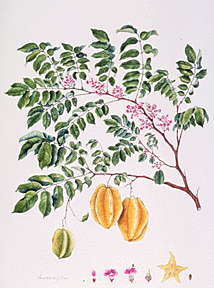



By Anthony Sommer, Star-Bulletin
Kauai watercolorist Geraldine Kam says botanical
illustrating isn't like painting still-lifes.
WHETHER it's scientific art or artistic science, botanical illustration is fine art with a message. Botanical artists portray their subjects in various stages of growth, with fresh leaves and old ones, with seeds, seed pods, buds, blossoms and fruit. The Honolulu Academy of Arts explains the technique as "blending scientific objectivity and artistic expression," and it should offer accurate identification of the plant pictured. Art from the garden
Geraldine Kam's botanical illustrations
capture Hawaii's flora with artful objectivityAn exhibit of 25 botanical illustrations by Geraldine King Tam, a resident of Kauai, opens Thursday at the academy. The watercolors feature native and introduced plants of Hawaii, including the African tulip tree, breadfruit, golden shower, mountain apple and lilikoi. The illustrations are among the 62 that appear in Tam's new book, "Paradisus: Hawaiian Plant Watercolors" that will be available at the academy shop and many island bookstores next week.
"These are not interpretations or still life," Tam said. "That's not what botanical art is. When I got out here, I knew nothing about tropical plants. They're all so big, and I couldn't get my tongue around those long Hawaiian names. So I started painting them.
"I really don't choose what I paint, the material chooses me. It's hit or miss, it's what I find in the garden or on the beach or what somebody brings me. If it's growing in my yard, I paint it. Walking on the beach, I may see this great plant flowering and think, 'What is it?' and I find out.
"Once a friend who lives on the other side of Kauai, at Kokee, called and said, I have some wonderful specimens of maile and mokihana," and she drove all the way to Kapaa where I live to deliver them. So I dropped whatever I was doing, and I painted them."
A natural drawback to botanical art is that painting from nature takes both timing and time. To create a painting, she collects the various parts of the plant at their peak, and then composes the drawing. Because the seeds and the pods and the flowers don't all appear at once, it may take her over a year to assemble the components of a single drawing.
Tam has been an artist all of her 78 years -- "People always want to know how old you are, so you might as well tell them"-- but her interest in botanical painting didn't begin until after she moved to Kauai in 1980. (The invitations sent by the academy to its membership to her opening reception next week mentioned that she was born in 1920. However, the bar code sticker for mass mailings under the recipient's address covered that line, and Tam said this was OK with her.)
She was born in Toronto, and attended McMaster University in Hamilton, Canada, and the Ontario College of Education at the University of Toronto. "I taught art for a while," Tam said, "and then I moved to New York to get a graduate degree in art education at Columbia." While at Columbia she met the well-known Hawaii-born artist Reuben Tam, and they were married in 1946.
"We lived in New York for 34 years, spending our summers on Monhegan Island off the coast of Maine. During the school year I taught at the Dalton School in New York City, a private coed prep school with a strong interest in art. I also taught ceramics classes, I made jewelry and I did printmaking," she said.
"During the summers, I'd go out on the rocks and paint seascapes and plants. It was about this time that my husband said to me, 'If you would concentrate on one thing, you might get good at it,' and after we moved back to Kauai, I found that once I had started botanical painting I had no time for anything else."
Reuben Tam died in 1991, and she has continued to live in their Kapaa home. "I pull an occasional weed, I do minimal housework and I don't like cooking. Painting is my life," she added.
Tam works almost entirely from living plant material, and only rarely from photographs. "If it's a plant that I don't expect to see again, one that grows high in the mountains or some other relatively inaccessible place, I take photographs and a few plant samples and work from those," she said.
"My feeling is that a good botanical drawing has to come from a good growing plant, something in three dimensions. You can't make it up, or at least I can't. People are sometimes forced to draw from pressed specimens, but I have to see how it grows to portray it as if it is really alive."
First copies of "Paradisus: Hawaiian Plant Watercolors" had not yet arrived from the printer in Japan at the time of this interview. A first shipment of the book, which is $49.95 a copy, is due to arrive in a few days.
"It's a coffee table sort of book, with a text written by the Australian botanist, Dr. David Mabberly. There are some technical details, but it is written for the lay person. It describes the habitat of each plant, its uses and the legends attached to it," Tam said. That makes it very useful, but mainly, you'll want to look at the pictures.

Fruits and Flowers:
Botanical PaintingsArtist: Geraldine King Tam
On display: March 11-May 2
Place: Honolulu Academy of Arts
Hours: Tuesday through Saturday 10:a.m. to 4:30 p.m. Sundays 1-5 p.m. The academy is closed on Mondays.
Cost: $5 general admission, $3 for seniors, students and the military. Members and children under 12 are free. This fee gives access to the entire academy.
Call: 532-8700
Gardening Calendar in Do It Electric!
Send queries along with name and phone number to:
Evergreen by Lois Taylor, Honolulu Star-Bulletin, P.O. Box 3080, Honolulu 96802.
Or send e-mail to features@starbulletin.com.
Please be sure to include a phone number.
Evergreen by Lois Taylor is a regular Friday feature of the
Honolulu Star-Bulletin. © 1998 All rights reserved.